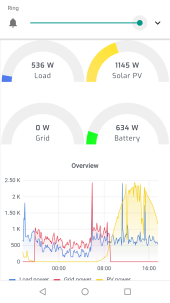I am running a fridge, freezer, mini fridge, microwave, coffee maker, hot water carafe, lots of lights, pellet stove, 2 desktop computers, all the network gear, directv gear, 2 tvs...
Not everything is on at the same time.
My base load on the following system runs from about 200-350 watts overnight to about 800-1000 watts during the day.
This is punctuated by a 5 minute spike to 2400W when making coffee, or to 2800 when microwave runs, etc. I can run both simultaneously because they are on different legs. I have warned my wife NOT to do that though. One is on inverter 1, other on inverter 2. Fridge on 1, freezer on 2. Careful assignment of circuits through the transfer switch to balance loads.
Mpp Solar 3048LV MK x2 in split phase supplying 240 to a Reliant Manual Transfer Switch I installed years ago next to my main panel for grid out generator support. Each fed by 150 amp circuit breaker, 300 amp bus bars, 150 amp class T fuses, pair of batteries. 150ah Lishen DIY, 160ah EVE DIY. Both with 100 amp 16s Overkill JBD.
240 split phase feeds the inverters for utility chargers and passthrough should there be insufficient solar or battery. Basically set up as a 10 circuit ups. But backwards.
12 used 235 watt panels on a good day in mid March charge from 15% SOC to 70% SOC.
Need more solar!
My freezer is an eleven year old Frigidaire, fridge is 9 year old Kenmore. I don't even see the compressor spikes. I put a kill a watt on each for 24 hours during my energy audit and found 2.02kwh for the fridge and 1.84kwh for the freezer. Or vice versa. In a 24 hour period. Normal use.
Hope you find this useful.
Good luck.




